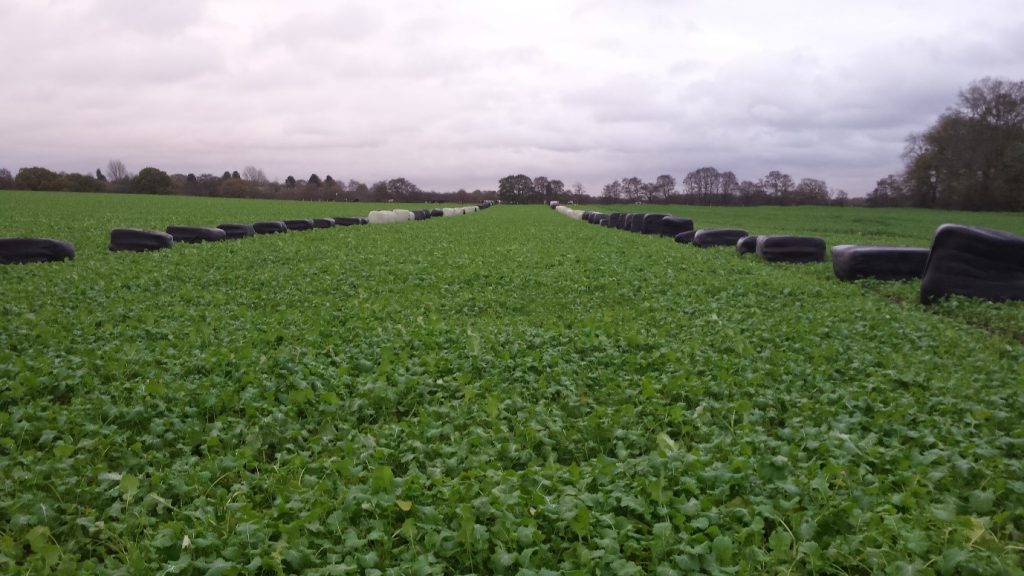Once mid-October has approached many farmers start to think about grazing their Kale, Redstart or Forage Rape crop which will take place between now and February.
In order to optimise the utilisation of these crops, there are a number of tips, as outlined below, which will help ensure you safely introduce brassicas to your animals and get the most from your crop this winter.

Measuring DM yield
Knowing the yield of your crop will help you plan your winter feed management. Knowing how many animals the crop can carry and over how long, will provide the information required to plan your feed budget.
To measure the DM yield of your brassica crop you will need the following:
- 1m2 square frame
- A large bag (old seed or fertiliser bag)
- Garden shears
- Scales
Take a number of samples across the field and pick representative sampling points.
- Place the frame in a representative area of the crop
- Using the shears cut each plant within the frame (about 10 cm from the ground)
- Place the harvested crop in the bag
- Using the scales record the weight of the crop per m2
- DM yield = Fresh weight per metre squared x 10,000 x estimated DM %
Referencing the table below will help you calculate how far to move your fence forward each day:
| e.g 270 kg weanling | ||
| A | Livestock Total Intake Estimate total daily intake per animal based on DM requirement of 3% of liveweight | 8 kg DM/day |
| B | Brassica % of Diet % of the diet that will be brassica (max. recommended is 70%) | 70% |
| C | Brassica Daily Requirement A x B | 5.6 kg DM/ animal |
| D | Number of Livestock | 25 |
| E | Daily Requirement from Brassica Box C x D | 140 kg DM |
| F | Estimated Crop yield | 0.8 kg DM/m2 (based on yield of 10 t DM/ha or 1 kg DM/m2 x 80% utilisation) |
| G | Total Daily Grazing Area Required Box E/F | 175 m2 of brassica |
| H | Length of Feed Face | 120 metre |
| I | Metres to move fence daily Box G/H | 1.5 metres per day |
Estimate days grazing per hectare
To estimate how many days a hectare of your crop will feed your animals for, use the following:
| e.g 270 kg weanling | ||
| A | Brassica Daily Requirement | 5.6 kg DM/ animal |
| B | Number of Livestock | 25 |
| C | Daily Requirement from Brassica Box A x B | 140 kg DM |
| D | Estimated Crop yield | 8000 kg DM/ha |
| E | Number of days per hectare Box D/C | 57 days |
 Grazing management of brassicas
Grazing management of brassicas
Changing from a diet of grass to a brassica is a significant dietary change and so to minimise the risk of rumen upsets it is important to introduce stock to brassicas gradually over a number of days. The following are key points to remember when grazing brassicas:
- Introduce stock slowly – initially 1-2 hours access per day and build up to full time access over 7-10 days
- Brassicas should form no more than 70% of the diet, with the remaining 30% coming from a fibre source such as silage, hay or straw
- Bales should be placed in the field, ideally during the summer to minimise machinery travelling when ground conditions are poor. This also reduces your workload in the winter
- Provide constant access to fresh water
- Strip graze to maximise the utilisation and move the fence daily
- Graze long narrow strips to ensure all animals have equal access to the crop and minimise trampling of the crop
- On sloping fields, start grazing from the top to reduce run-off
- Brassicas are low in certain minerals especially selenium, iodine, copper and cobalt. Animals should be given a bolus to ensure adequate minerals are supplied. Ask your vet for advice
- Monitor utilisation to ensure animals are being offered adequate feed. Animals should be content and the crop should be well utilised

